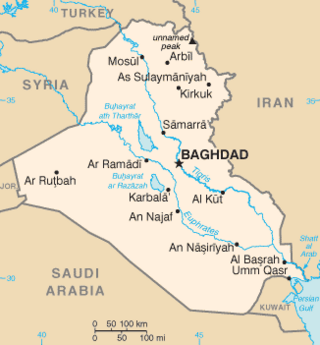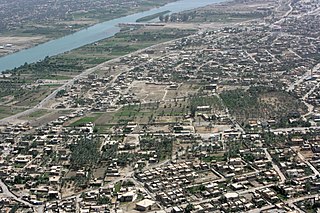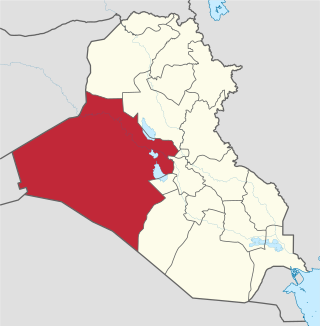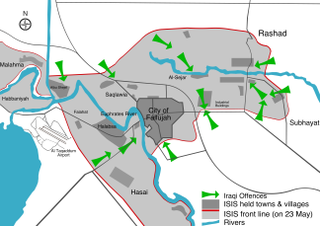Related Research Articles
Events in the year 2004 in Iraq.
Events in the year 2005 in Iraq.

Tal Afar is a city in the Nineveh Governorate of northwestern Iraq, located 63 km (39 mi) west of Mosul, 52 km (32 mi) east of Sinjar and 200 km (120 mi) northwest of Kirkuk. Its local inhabitants are exclusively Turkmen.

The Second Battle of Ramadi was fought during the Iraq War from March 2006 to November 2006, for control of the capital of the Al Anbar Governorate in western Iraq. A joint US military force under the command 1st Brigade Combat Team, 1st Armored Division and Iraqi Security Forces fought insurgents for control of key locations in Ramadi. Coalition strategy relied on establishing a number of patrol bases called Combat Operation Posts throughout the city.
Chlorine bombings in Iraq began as early as October 2004, when insurgents in Al Anbar province started using chlorine gas in conjunction with conventional vehicle-borne explosive devices.
The 2008 al-Qaeda offensive in Iraq was a month-long offensive conducted by al-Qaeda in Iraq against the multinational coalition of USA, UK, Australia and Poland.

The Anbar campaign consisted of fighting between the United States military, together with Iraqi security forces, and Sunni insurgents in the western Iraqi governorate of Al Anbar. The Iraq War lasted from 2003 to 2011, but the majority of the fighting and counterinsurgency campaign in Anbar took place between April 2004 and September 2007. Although the fighting initially featured heavy urban warfare primarily between insurgents and U.S. Marines, insurgents in later years focused on ambushing the American and Iraqi security forces with improvised explosive devices (IEDs), large scale attacks on combat outposts, and car bombings. Almost 9,000 Iraqis and 1,335 Americans were killed in the campaign, many in the Euphrates River Valley and the Sunni Triangle around the cities of Fallujah and Ramadi.
2006 in Iraq marked the onset of a sectarian war in Iraq and remains the deadliest year of the Iraq War since the 2003 invasion of Iraq.

This list details terrorist incidents occurring in Iraq in 2007. In 2007, the US sent 20,000 additional troops into combat as part of a troop surge. There were 442 bombings in 2007, the second-most in a single year during the Iraq War. Major events included a January 16 attack on Mustansiriyah University, which killed 70 and injured 180, and February 3 bombings at the Sadriyah market in Baghdad, which killed 135 people.

This article details major terrorist incidents in Iraq in 2008. In 2008, there were 257 suicide bombings in Iraq. On February 1, a pair of bombs detonated at a market in Baghdad, killing 99 people and injuring 200. Two other particularly deadly attacks occurred on March 6, and June 17.
In 2009, following the withdrawal of US forces from Iraqi cities on 30 June, a campaign of car bomb attacks was conducted throughout Anbar Governorate. In early 2009, U.S. forces began pulling out of cities across the country, turning over the task of maintaining security to the Iraqi Army, police, and their paramilitary allies. Experts and many Iraqis worried that in the absence of U.S. soldiers, AQI might resurface and attempt mass-casualty attacks to destabilize the country. There was indeed a spike in the number of suicide attacks, and through mid and late 2009, al-Qaeda in Iraq rebounded in strength and appeared to be launching a concerted effort to cripple the Iraqi government.

This is a list of terrorist incidents in Iraq during 2010. Major attacks include a 1 February attack killing 54 in Baghdad, and a 10 May attack killed 45 at a fabrics factory in Hillah.
The 2013 Hawija clashes relate to a series of violent attacks within Iraq, as part of the 2012–2013 Iraqi protests and Iraqi insurgency post-U.S. withdrawal. On 23 April, an army raid against a protest encampment in the city of Hawija, west of Kirkuk, led to dozens of civilian deaths and the involvement of several insurgent groups in organized action against the government, leading to fears of a return to a wide-scale Sunni–Shia conflict within the country. By 27 April, more than 300 people were reported killed and scores more injured in one of the worst outbreaks of violence since the U.S. withdrawal in December 2011.
From 15 to 21 May 2013, a series of deadly bombings and shootings struck the central and northern parts of Iraq, with a few incidents occurring in towns in the south and far west as well. The attacks killed at least 449 people and left 732 others injured in one of the deadliest outbreaks of violence in years.

The Battle of Ramadi was a battle launched by the forces of Iraq to successfully recapture the city of Ramadi from the Islamic State of Iraq and the Levant (ISIL), which had taken the city earlier in 2015 in a previous battle. Air power was a major component of the battle, with the United States and other nations conducting over 850 airstrikes in the Ramadi area from July 2015 to late February 2016, and the US crediting airstrikes with 80% of the reason why the city was recaptured. By February 2016, Iraqi forces successfully recaptured the city after two and a half months of fighting. It was predicted that it would take several months to clear the city of the bombs ISIL left behind, with at least 9 months needed to clear the city's Tamim District. At the time, Ramadi had suffered more damage than any other city or town in Iraq.

The Anbar campaign (2015–2016) was a military campaign launched by the Iraqi Armed Forces and their allies aimed at recapturing areas of the Anbar Governorate held by the Islamic State of Iraq and the Levant (ISIL), including the city of Ramadi, which ISIL seized earlier in 2015. The United States and other nations aided Iraq with airstrikes.

The siege of Fallujah was an offensive launched in February 2016 by the Iraqi government against the Islamic State of Iraq and the Levant (ISIL) in al-Karmah and in the city of Fallujah, with the aim of enforcing a siege of the latter. During the early stages of the operation, local Sunni residents revolted against ISIL for a period of three days. On 22 May, after completing preparations around the city, the Iraqi Army and supporting Shi'ite militias launched the third Battle of Fallujah.
This is a timeline of events during the War in Iraq of 2013 to 2017 in its final year.
References
- 1 2 "Insurgents Kill 140 as Iraq Clashes Escalate". The Washington Post . Archived from the original on 3 October 2018. Retrieved 20 September 2017.